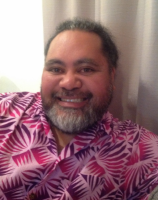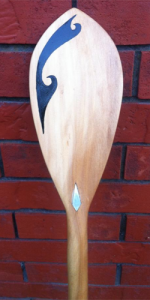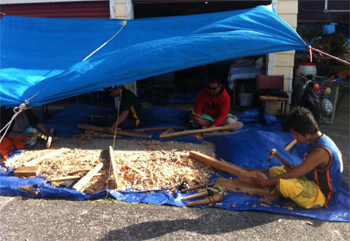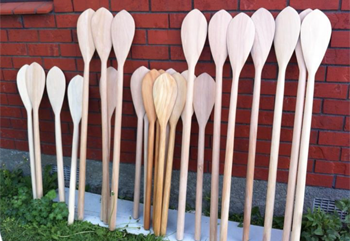Aloihio Kave Kelemete is an educator of Tokelau descent. He is currently living in Wellington with his wife Nenah and two primary aged children, Kewa and Telehia.
In this blog, Hio explains some important aspects of Tokelau identity and offers suggestions on how we can promote Tokelau language and culture in our schools and classrooms.
Dedicated to my amazing uncle, Ineleo Tuia, and my heroes Telehia, Peato and Hilivelia Kelemete. Rest in His loving arms.
Tokelau mo te Atua, Te Atua mo Tokelau
Tokelau for God, God for Tokelau
Ko Tonuia i Falefitu
Tonuia lives in Falefitu (Atafu atoll)
Nonu ma Alo i Falefa
Nonu and Alo live in Falefa (Nukunonu atoll)
Takoto Kava i Faleiva
Kava lies in Faleiva (Fakaofo atoll)
Ko palega o fenua
It is the beauty of the land
E fakatulou atu ki te mamalu o Whaiakoga o Aotearoa.
Malo ni!
My parents were both born in Tokelau. Dad came to New Zealand in the mid 60s as a young man. Mum came in the late 60s with her family. Dad was a professional wrestler when he first arrived. When he married my mum they settled in Petone. Life for early Tokelau settlers was overwhelming; homesickness was rife, and adapting to a different lifestyle and environment was a constant struggle. However, the consensus was that the future education of their children was a priority.
My aunty Huihana Lemisio says the first time she saw cars from the boat she thought they were really big pigs running fast along the beachfront because she’d never seen cars in Tokelau. To begin with, some early Tokelau settlers didn’t know how to read English so food shopping was interesting. Stories have been shared with us about how difficult it was to differentiate between tin foods such as fish, corned beef, and pet-food!
What does it mean to me to be a Tokelau?
Being New Zealand born, it can be confusing at times trying to balance the Tokelau way of doing things and the New Zealand lifestyle. Our parents tried really hard to keep the Tokelau culture and language alive, while at the same time pushing for us to further our education.
We had Friday evening classes to learn about Tokelau language (te gagana faka Tokelau) and culture, as part of "Sunday School". We would learn songs, dances, and games as well as "aganuku" (tikanga or culture).
As children we spoke both Tokelau and English at home but as we moved through school, English became more dominant. I’m grateful for my bilingual childhood because now I can understand te gagana and speak it but I’m not as strong as a first language speaker. There are a lot of similarities with te reo Māori and other Pacific languages.
There are constant discussions regarding the Tokelau alphabet, in particular the debate of using f versus wh. In Atafu and Fakaofo communities the f is used in written text, whereas in Nukunonu communities, the use of wh is promoted. Phonetically, f or wh is pronounced hw.
Tokelau Aganuku
In Tokelau we have the Inati system of sharing. Each family is allocated a certain amount of the available resources so, for example, if a group goes out fishing, the fish are put in piles and shared according to each family "allowance" – this ensures everyone gets a share.
The "Hua" ceremony welcomes special guests, similar to a pōwhiri or the Samoan ‘Ava ceremony. There are special phrases that are recited and the baby coconut or "hua" is presented to the guests.
The "pa" or mother of pearl pendant necklace is presented to girls usually on a special occasion such as a wedding. The "pa" is our most precious taonga, like a pounamu.
How important is the language to the Tokelau culture?
The theme for Te Vaiaho o te Gagana Tokelau this year is:
“Tokelau ke mau ki te gagana a nā tupuna auā he tofi mai te Atua.”
"Tokelau hold fast to the language of your ancestors because it is an inheritance from God."
Around one third of Tokelau living in Aotearoa are Tokelau language speakers. To protect te gagana Tokelau for future generations it is vital that it is nurtured and shared.
I love that the Tokelau language is celebrated every year now with a special week. It’s great for Tokelau to have their language acknowledged and it provides an opportunity for our parents to share their knowledge with the younger generation and with all New Zealanders. Our parents are the experts.
As a lead up to Tokelau Language Week we are preparing for a dance night (po fatele). Each atoll group (Atafu, Fakaofo, and Nukunonu) is practicing song and dance to share with each other. I like to think of it as a giant dance-off, with each group taking it in turns to share a fatele or two. This creates a whole big family feel and brings us together as Tokelau to celebrate who we are.
Before Tokelau Language Week the only thing that brought us all together as a Tokelau community in New Zealand was the biennual Easter tournament, where we would gather together for a sports and cultural exchange. Now with Tokelau Language Week it’s every year and it keeps getting bigger and bigger so we’re celebrating the whole week with special events.
The Friday Tokelau culture and language school is still going but now it’s every Sunday. The teachers who are leading that are the kids who went through the school themselves. The knowledge is passed on and we are doing our best to support the next generation with the support of our parents. Recently the community (under the guidance of artist and master carver Tufala Tavite) undertook the task of carving foe/whoe or paddles as a means of re-connecting our young people with a traditional art.
You can check out more of Tufala’s artworks on his Kaviki Facebook page.
Some other arts based initiatives which promote Gagana Tokelau for young people in Wellington are a Fatele-based programme called Koli with Me, run by dance tutor Selina Alesana Alefosio; and a poetry programme targeting female Tokelau writers called Mafine Toa, run by Manea Pasilio.
What am I doing in school for Tokelau Language Week?
I’ll be at my kids’ school teaching Tokelau songs and dance.
As well as simple words and phrases, I might even try some weaving.
We’ll be trying out some Tokelau dishes and eating what we prepare of course! A favourite treat is "puleleti" – grated coconut and caramelised sugar. "Puta" is our special fried bread. It’s a bit different to fried bread from other Pacific nations, it’s sweeter and buttery.
To make Puleleti:
Ingredients
- 1 cup of desiccated coconut (or freshly scraped coconut)
- ½ cup of sugar
- A dash of cream (if you can't get any fresh coconut)
- Tin foil for wrapping
NB: Double or triple the ingredients as needed.
Method
- In a bowl, mix together the desiccated coconut and cream (just enough to bind the coconut.)
- Melt the sugar in a pan over a low heat to a light brown colour then take it off the heat. Be careful not to burn the sugar.
- Add the coconut/cream mixture (be very careful!) and stir. Let it cool slightly then wrap spoonfuls into golf ball sized spheres in tinfoil squares. Allow to cool, then enjoy.
What advice do you have for teachers of Tokelau students to support their language and culture?
- Using English vowel sounds with Tokelau language doesn’t work. Tokelau shares the same vowel sounds as other Pacific nations – a as in far, e as in elephant, i as in key, o as in on, and u as in pool.
- Get the pronunciation of names right. These are often names of an ancestor or a dearly loved family member, so it’s important to get names right.
- Connect with families. Often parents want to be involved in learning but feel they don’t have the confidence to do so. Utilise them as experts during Tokelau Language Week (and beyond) to help with phrases, song, dance, and cooking.
What can teachers do to showcase Tokelau language and culture to all students?
Use simple phrases throughout the day:
- Omamai – come here (to a group)
- Fakalogo – listen
- Kikila mai – look this way
- Hauni – get ready
Practice weaving with flax or paper. Make little place mats, fish, flowers or ili/fans.
Check out the storybook reader Ko Te Nonu by Epi Swan. She describes a day of fishing in a paopao/outrigger canoe, followed by a mock Inati by the local community. Junior classes might enjoy fishing for fish-magnets and then sharing out the catch Inati-style to practice the ideology of caring for each other by ensuring that everyone gets a share.
Tokelau ke mau ki te gagana a nā tupuna auā he tofi mai te Atua.
Tokelau hold fast to the language of your ancestors because it is an inheritance from God.
Tokelau mo te Atua, Te Atua mo Tokelau.
Tokelau for God, God for Tokelau.
You might like
Tokelau Language Week
This special week gives speakers of Gagana Tokelau the chance to be experts in the classroom, and allows whānau and the wider Tokelau community to see their language and culture being treasured in New Zealand schools. This page provides ideas, resources, and inspiration to help you learn and celebrate Gagana Tokelau with your school community.





